Quick History
The Republicans controlled the redistricting process in 2000, shifting the map from a 9-7 Democratic advantage to a 9-6 Republican one. (Michigan lost a seat in reapportionment.) They did this by redistricting three seperate pairs of Democratic incumbents into the same districts, thereby creating two new open Republican seats elsewhere. Architect of this plan? None other than then-state-senator Thaddeus McCotter, who oh-so-thoughtfully created one of those new open districts around his home base.
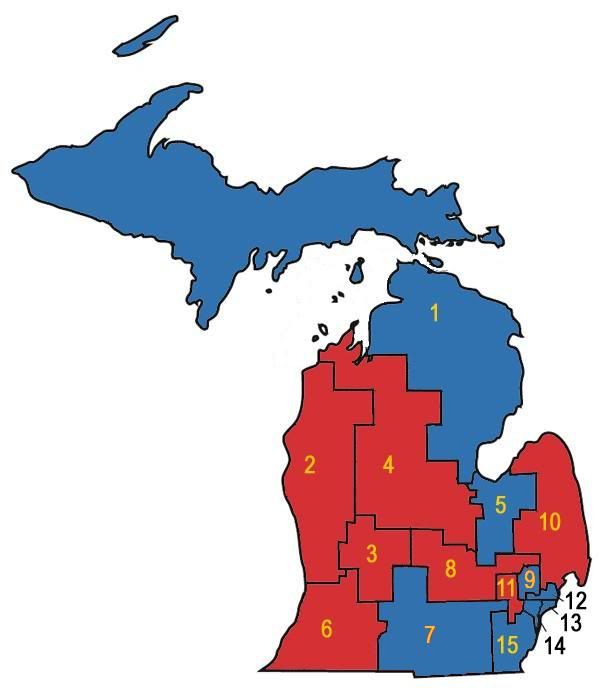
The GOP plan had turned into a little bit of a dummymander, since by 2008 the Democrats had flipped two districts to get an 8-7 advantage. This week's election, however, has restored the Republican's 9-6 edge. The 1st and 9th districts are in opposite hands from the 2002 elections; all other districts are controlled by the same party that won them eight years ago. (Wikipedia’s version of the pre-Tuesday districts is above for reference.)
The Genesis of this Plan: Failed Attempts
One of my consolations on election night was the idea that even with control over redistricting again, the Republicans couldn't really make it any worse. At the time, it looked the the Democrats were going to be down to five districts: Dearborn-Ann Arbor, Flint-Saginaw, Southfield-Warren, and the two Detroit districts. That seemed like pretty much the rock bottom base of support for the Democrats in Michigan. But then Gary Peters pulled out a narrow victory, and I started to look to see whether the Republicans could get the Democrats down to five after all. Michigan is almost certainly losing another district, so let's see if it can be made a Democratic one.
Four of the six Democratic seats seemed pretty much untouchable. The VRA-protected Detroit-based 13th and 14th districts are, of course, ridiculously Democratic. Sander Levin's 12th district pulls together an only somewhat less-ridiculously-Democratic set of inner suburbs on Detroit's north side. And despite Dale Kildee's narrower-than-expected win on Tuesday, Flint is big enough to dominate pretty much any district you could conceivably put it in. That leaves Gary Peter's 9th district and John Dingell's 15th district as the remaining targets.
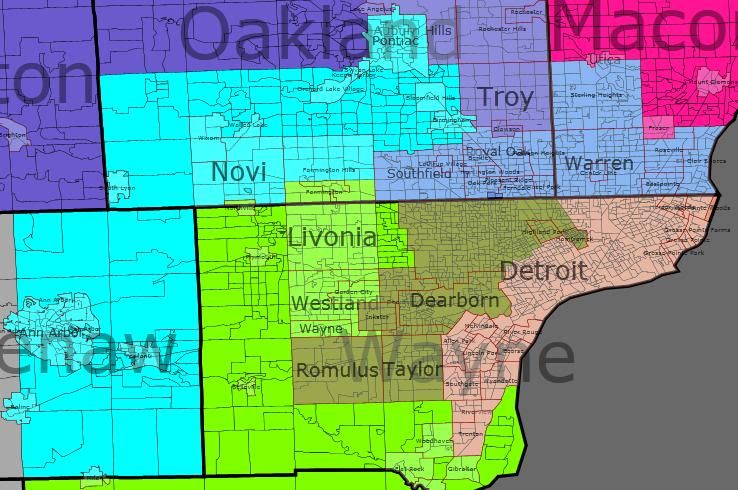
My first attempt actually took on John Dingell's district. Stretching from blue collar Dearborn to the university town of Ann Arbor, it was created as one of the three "pairing" districts, setting up then-Representive Lynn Rivers against Dean of the House Dingell. Dearborn was easy to move into John Conyer's 14th district. Ann Arbor has to end up in Democratic district, so I swung Gary Peter's 9th district around to pick it up. Thad McCotter's 11th then mostly gives up its claim on Oakland county to pick up the rest of the dismembered 15th.
The problem with this plan from a GOP perspective is what it does to McCotter. The distict is probably about 60% – 70% new to him, and it's not nearly as Republican as his old district. I haven't run the numbers, but just from eyeballing it, I would be surprised if this version of the 11th district didn't have a Democratic PVI.
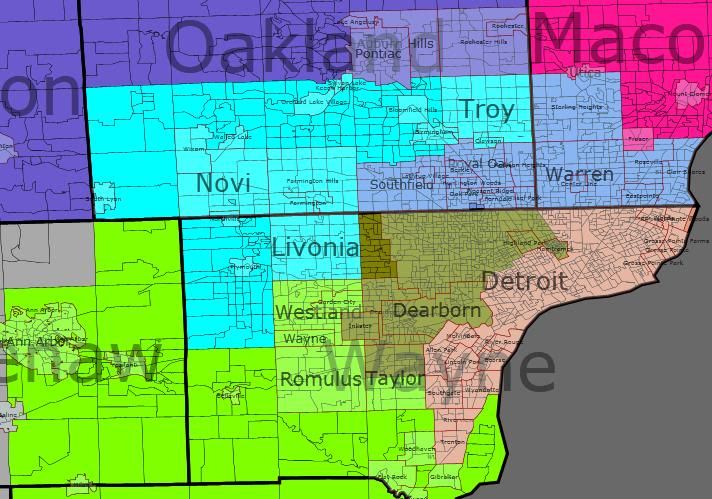
My second attempt left Dingell's district more-or-less alone. (As pictured, all of Dingell's hometown of Dearborn ends up in Conyer's district, but this could possibly be played with.) Instead I merged McCotter's 11th district with Peter's 9th district. The resulting district has about half of its population come from each district. (Old Peters in blue; old McCotter in green.) It cuts out the most Democratic parts of each district (Wayne, Westland, and Garden City for the 11th; Pontiac, Auburn Hills, and Royal Oak for the 9th). Again, I haven't run the numbers for PVI; I suspect it's a Bush '04-Obama '08 district.
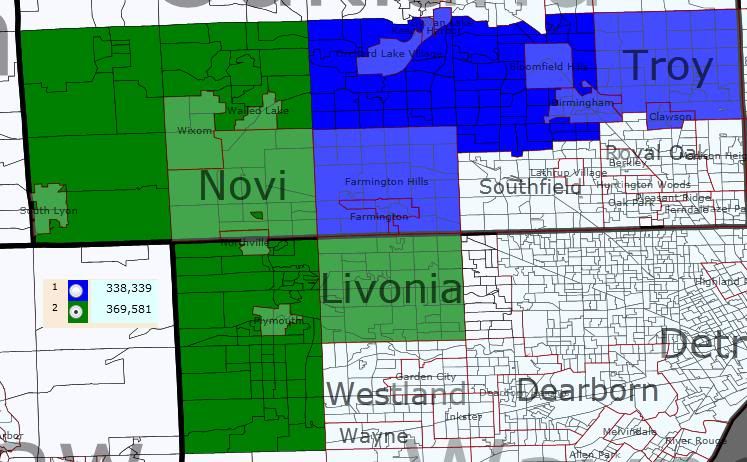
McCotter probably isn't the best candidate for an incumbent vs incumbent race, but this district — in isolation — would probably suit the state GOP fine.
The problem is what the rest of the state looks like.
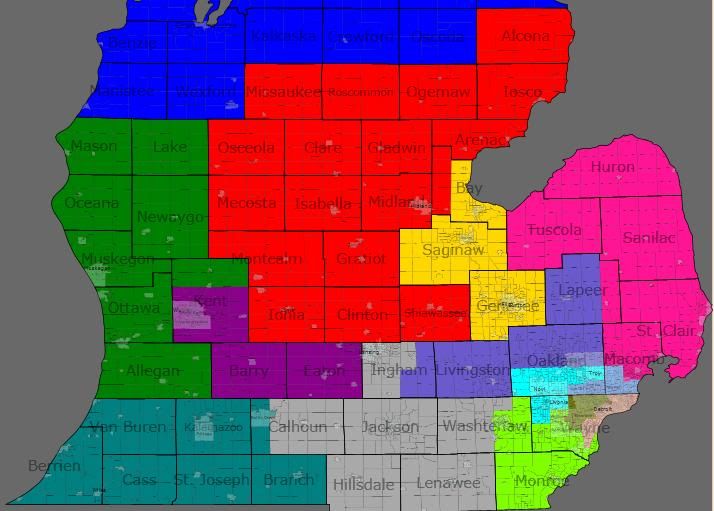
Merging the 9th and 11th pulls Mike Roger's 8th district further east and north. This saddles the already swingy 7th district just won by Tim Walberg with heavily Democratic Lansing. The 7th, in turn, now donates Democratic-leaning Battle Creek to Fred Upton's already even-PVI 6th district.
The Solution
So if I couldn't dismantle Dingell's district without giving McCotter too much hostile territory, and if merging McCotter's district and Peter's district resulted in weaker districts for Walberg and Upton, then what?
I was stumped for about a day, when the answer occured to me: attack Sander Levin's 12th district instead.

By bringing the Detroit-based 13th district north across Eight Mile into Macomb county, I could merge the Oakland portion of the 12th district into the 9th. (The old 12th is roughly outlined in white.)
Brief District-by-District Rundown
I'm considering working through the data to get firm PVIs for the proposed districts. For now, you have eyeballing-it. I did refer to the 2004 and 2008 numbers while drafting; I just never actually ran the calculations.
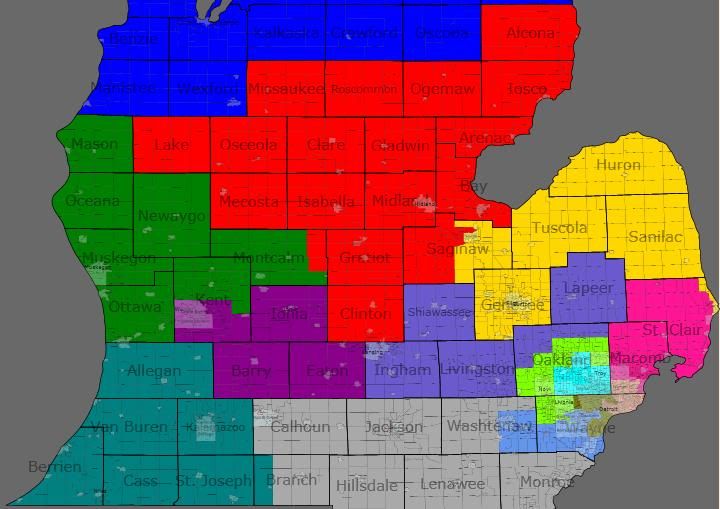
1st District (Blue)
This district is newly captured by Republican Dan Benishek. In the 2000 redistricting, this district was pulled down the Lake Huron coast towards Bay City as part of the dismantling of then-Representative Jim Barcia's district (he got paired with Dale Kildee in the 5th). Without such concerns, I pulled it down the Lake Michigan shoreline instead. Adding the Traverse City area instead of the upper Saginaw Bay area should make this district just slightly more Republican. Traverse is also a better cultural fit for the district. (Note that everything not pictured in the north of the state is in this district.)
2nd District (Green)
This district is currently Michigan's most Republican district by PVI. I don't think my alterations will change that. It gives up its northern reaches to the new 1st and stretches inland, taking in Grand Rapids' northern suburbs and exurbs.
3rd District (Purple)
The primary Republican concern with this district is making sure it has enough suburban/exurban territory to overwhelm the Democratic urban core in Grand Rapids. It gives up some territory north of the city and gains Eaton county to the east. I think this will be slightly more Republican than the existing 3rd.
4th District (Red)
As currently configured, this district is something of a left-overs district, taking in the northern counties not in the Upper Peninsula-based 1st or the Lake-Michigan-coast-based 2nd. Under my proposal, it becomes a somewhat more focused Central Michigan district. Largest city (and hometown of incumbent David Camp) Midland is now in the center of the district instead of on its eastern fringe. It takes in all of Democratic Bay county, but I think the rest of the territory is Republican enough to handle it.
5th District (Yellow)
The proposed 5th district is much like its 1990s-district-plan predecessor, taking in much of the Thumb instead of Bay City. This is because eliminating Levin's 12th district pulled Candice Miller's 10th district out of the Thumb. Since it's over that way anyway, it runs a tendril down the St Clair River to relieve Miller of smallish-but-heavily-Democratic Port Huron.
6th District (Teal)
Not much changes for the 6th. It exchanges a few townships in Calhoun county for a few in Branch, and takes in the rest of Allegan county. That last change should make it slightly more Republican. Incumbent Fred Upton should remain fine here.
7th District (Grey)
This proposal's greatest weakness. Newly re-elected Tim Walberg has a district with a PVI of R+2. Getting Monroe county from the dismantled-by-reapportionment 15th in exchange for giving the new 3rd Eaton county is essentially a wash. I just don't think that there's much the Republicans can really do to shore this district up.
8th District (Slate Blue)
Still subsumes Lansing in a sea of Republican-heavy exurbs. This configuration gives up somewhat-Republican Clinton county to gain very-Republican Lapeer county, so Mike Rogers should be happy.
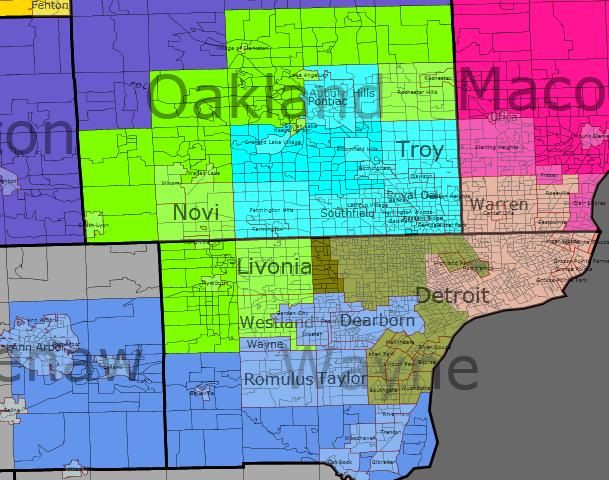
9th District (Cyan)
The new 9th is one of the center-pieces of the plan. It combines most of Gary Peter's current 9th with about half of Sander Levin's current 12th. If it came to a primary, I'm not sure what would happen. Where the current 9th was designed as a Republican seat that's just slipped away, this 9th would be a Democratic safe seat, anchored by Southfield, Royal Oak, and Pontiac.
10th District (Deep Pink)
Candice Miller's 10th is pulled south by the elimination of the old 12th. Losing most its rural hinterland, the new 10th is definitely more Democratic than the old one, but I don't think it's that much more. I think Miller should still be fine. In one of the rare set of calculations I did do, the portions of Macomb county not in the district (ie, in the new 13th) voted for 63% for Obama. The portions of Macomb in the district voted only 52% for Obama. That probably means that Bush won the new 10ths portion of the county in 2004 (here, we're back to no calculations.)
11th District (Lime Green)
In order to shore up McCotter, the district loses three of its inner surburbs and snakes around the north side of the new 9th to pick up some more heavily Republican territory. McCotter should put up much better numbers in this reconfigured district.
12th District (Cornflower Blue)
With the dismantling of the old 12th, I reused the district designation for the reinvention of Dingell's dismantled-by-reapportionment 15th. The new 12th loses Monroe county to pick up the southern portions of Downriver. I'm pretty sure this will push its PVI in an even-more Democratic direction, and Dingell (and/or his successors) should be safe here all decade.
13th District (Salmon?)
The other centerpiece of this plan. It takes in roughly similar portions of Detroit as its predecessor (along with the Grosse Pointes and Harper Woods.) Instead of stretching into Downriver, though, it crosses over into southern Macomb, snatching away the eastern half of Levin's district and saving Miller from having to take on the most Democratic parts of the county. VRA: 53% black, 42% white.
14th District (Olive Drab)
Conyers' new district takes in basically the same portions of Detroit as his old one. The primary difference are the addition of Redford township, the subtraction of any part of Dearborn, and the taking in of the northern half of the Downriver communities instead of the western half. VRA: 53% black, 34% white.
Pre-Conclusionary Note
I was originally concerned about whether this was too much county-splitting in the Detroit area, but it's actually less than currently exists. Currently, the tri-county Detroit metro area has the following configuration:
Wayne: 2 full districts (13th, 14th), 2 partial districts (11th, 15th)
Oakland: 1 full district (9th), 3 partial districts (8th, 11th, 12th)
Macomb: 2 partial districts (10th, 12th)
for 10 total county-fragments.
Under this new configuration, the tri-county Detroit metro area looks like this:
Wayne: 1 full district (14th), 3 partial districts (11th, 12th, 13th)
Oakland: 1 full district (9th), 2 partial districts (8th, 11th)
Macomb: 2 partial districts (10th, 13th)
for 9 total county-fragments.
Conclusion (TL;DR version)
By eliminating Levin's 12th district, I created four packed super-safe districts for the Democrats in the metro Detroit area, with one other safe Democratic district in the Flint-Saginaw area. Republican incumbents in the 1st, 3rd, 6th, and 11th districts are shored up. Republican incumbents in the 4th and 10th districts take minor hits. The Republican incumbent in the 2nd district needed no help; and the one in the 7th district is unhelpable. This plan would more or less lock in an 8 GOP – 5 Dem – 1 swing district pattern for the rest of the decade.
Eaton is not as Republican as Ionia is, with Delta Township having a lot of Democratic votes in it. Delta and Chester Townships alone gave Obama 10,602 to 7,632, or around 3,000 of his 5,000 vote advantage in the county, plus the potion of Lansing that’s in the county. And it was one of two counties in the 7th that voted for Schaeur over Walberg. Even though that wouldn’t be enough to make a difference in a year like 2010, if I’m not mistaken wouldn’t the new 3rd would have been won by Obama in 2008? Probably wouldn’t make much of a difference at a local level, though.
I think Rep.-elect Walberg is the Republican Lansing would most like to throw under the bus anyway. Something tells me his birther self and any Republican with a shot at statewide office in a blue state like Michigan don’t get on well at parties, and he’s going to generate some negative publicity unless he shuts up.
Not a terrible outcome for the Democrats, who could wind up with just as many seats in Michigan as they’ll have in the 112th Congress in the 113th Congress if they have even a neutral year in 2012.
As for a potential matchup between Reps. Peters and Levin, I have an inkling Levin may be planning to retire anyway; he’ll be 81 by the time of the 2012 elections.
It is disappointing that the Republicans control so many state legislative chambers.
either Eaton (a.k.a. Charlotte, Eaton Rapids, and west Lansing) is taken out of Walberg’s district or parts of Ingham aren’t included, then he’ll be fine unless there’s some massive 60-80 Democratic wave in the next few years. I would agree with you on his craziness if the voters in the district hadn’t ALREADY voted him in once. The fact that in even a Republican-leaning low-turnout group like this years electorate returned Walberg to Congress says a lot about the mood people are in right now.
I don’t really see the benefit of redistricting Walberg out of existence just to put Peters and Levin together, since Republicans in the long run may have to worry more about what happens when Upton retires or what happens if Rogers decides to make a run statewide or actually gets a tough opponent. Throwing these Democratic-leaning counties in with Republican-leaning rural areas can only work for so long since Republicans at the statewide level don’t wrack up the kind of margins in rural areas outside of West Michigan that they do in other Midwestern states.
I say they try to shore up Benishek by putting Traverse City back into his district, then try to make either the 6th (Upton) or the 3rd (Amash) stronger unless Upton gives some hints he may retire if he doesn’t get the chairmanship of Energy in the next Congress
MI-6 (home), MI-2 (college)
Previously working for Schauer (MI-07) and living outside of AA I knew the Democrat’s goal (if they held re-districting power) was to cut up McCotter’s district and push the liberal Lansing regions into the 7th and give the Republican sections to Rogers and the western districts. Also, they wanted to split Candice Miller’s district with a bit of Levin’s and a bit of metro Detroit to make 2 more democratic seats.
I really hope the Republicans can’t split Levin’s district anymore because then they would need to hurt one of their own incumbents.
I like your second attempt because it took me out of McCotter’s district. If the Dems controlled the process, it would probably be McCotter that would be redistricted out of office. Instead, we could get stuck with him for many more years. I hope nothing close to your final solution happens. That would put me into a very Republican district.
My initial instinct was the GOP would target Peters and Levin. But who knows what they’ll do.
… here's my current version of a Democratic gerrymander.
[Credit to both pbratt's diary and koolbens comments in this thread for inspiration for this plans versions of the 3rd and 6th districts, respectively.]
Overview: At worst a 7-7 map; at best 11-3 Democratic; meant to be 10-4 Democratic.
This map targets all of McCotter, Amash, Upton, Walberg, and Rogers. McCotter's district disappears. Amash and Upton suddenly find themselves in urban-heavy districts. And Walberg and Rogers now share a district dominated by Ann Arbor.
Benishek's 1st (blue) expands slightly into the 4th. It's still potentially winnable by a good Democratic candidate.
Huizenga's 2nd (green) is radically altered. He'll have to introduce himself to a districts that's probably 70%+ new. Fortunately for him, they're mostly Republicans.
Amash's 3rd (purple) is now super-urban, consisting solely of portions of Kent and Muskegon counties. This district has a even PVI.
Camps' 4th (red) has lurched west, taking in the northern half of the old 2nd. Camp should be safe here.
Kildee's 5th (yellow) drops Saginaw to pick up the Thumb from Candice Miller. It will be less Democratic, but I still believe that Flint is too dominate for Republican victory.
Upton's 6th (teal) now stretchs east to pick up Battle Creek. As an entrenched incumbent, he'd probably hang on for a while. But a retirement or Democratic wave could easily result this district flipping parties.
Walberg's 7th (grey) now houses both Walberg and Rogers in a district containing all of Ann Arbor's Washtenaw county. I'm not 100% sure that Washtenaw can dominate this district enough to make it completely safe for the Democrats, but it certainly has a heavy Democratic tilt.
Roger's 8th (slate blue) no longer houses Rogers. Worse for him, it now stretchs up to Saginaw and Bay City instead of east to northern Oakland. This is completely safe Democratic district.
Peter's 9th (cyan) is exactly like the one in my GOP gerrymander. The difference here is that Levin still has a district to run, even if he doesn't live in it.
Miller's 10th (deep pink) loses the Thumb to take in the more-Republican-y parts of Oakland county that I stripped from Rogers and McCotter. It's technically an open seat — Miller lives in the new 12th — but whichever Republican runs here wins.
McCotter's 11th disappears. Completely. I reuse the desigination for Dingell's district. (See below.)
Levin's 12th (cornflower blue) takes in the most Democratic parts of Macomb. Levin doesn't live here any more (Miller does), but it's a solidly Democratic district for whoever runs.
Clarke's 13th (salmon?) stretches to take in more of Downriver. VRA: 50% black, 37% white.
Conyer's 14th (olive drab) swings west to take on the core of McCotter's turf, including his hometown of Livonia, subsuming the most Republican parts of Wayne county with the western half of Detroit. VRA: 54% black, 40% white.
Dingell's 15th is renumbered the 11th (lime green). He loses Ann Arbor and now streches into Lenawee in the south, but this is still a solidly Democratic district.
I have to say, this is one of the best redistricting diaries I’ve seen in terms of depth. Gov-elect Snyder bills himself as “one tough nerd”–is he the kind of nerd that reads SSP in his spare time and is taking notes?
MI-08 resident, here. I’ve been wishing for some time that someone unsaddles ultra-conservative Livingston from us (Lansing, here). Mike has his office based out of Lansing, but beyond that, the only time Livingston County-based Mike is in Lansing is to fundraise. It’s like not even having a congressman. Any redistricting couldn’t be much worse than the current one.
Interesting discussion, but I think you’re missing the point on this plan. Gary Peters will not be given a solid Democrat distict in the middle of Oakland County. I agree that carving up Levin’s 12th is the way to go, but I think you might see something more like this in the Metro Detroit area:
9th (Peters)- Republicans level the playing field here by dumping Royal Oak and Berkley and moving the district north and west. Would pick up all of Orion, Independence Townships, Addison, Oxford, Brandon, Groveland and Springfield. Also takes northern half of Farmington Hills.
10th (Miller)- Extends south along the lines of this plan picking up virtually of that proposed in this plan.
11th (McCotter)- Dumps Van Buren Twp. in Wayne County and picks up Rose and Holly Twp. in Oakland. Cuts Farmington Hills in half taking in the southern half.
12th (Dingell)- Most of out-county Wayne including Dearborn, all of downriver and western townships (except Canton). Would extend out to pick up Ann Arbor and most of current Washtenaw 15th.
13th (Clarke)- All of Detroit not included in new 14th, the Pointes and River Rouge, Melvindale. Given Detroit’s population loss, this makes perfect sense.
14th (Conyers)- Breaks new ground by including northern Detroit with SE Oakland County (Southfield, Royal Oak, Oak Park)and Warren, Eastpointe, Roseville in Macomb. Solid Dem seat with potential for a congressional newcomer.
There are still a lot of calculations needed on this plan, but it leaves 8 solid Republican seats, 4 solid Dem seats, one leaning R seat (9th) and toss-up in the 7th.
Thanks for the shoutout as well borodino21. I’ve done a bit of closer analysis of your plan, and calculated the strength of your districts because on the Democratic Baseline (which is based on the Democratic vote share for the Board of Education Races.
Before I begin the analysis, I think that this plan is going to be facing a couple of problems. First, you have a number of GOP incumbents who are not going to like their new homes. Miller in the 10th will not like having a tougher district, McCotter will not want to be facing a challenge by Glenn Anderson in 2012, and Tim Walberg is going to be in a seat that is going to be somewhat different and open to a conservative Democratic challenger. Secondly, the Apol standards are pretty stringent about checking some of your districts, most notably the division Wayne County into four districts, when the standards clearly stress compactness and frown on districts crossing county lines. I’m not saying that the GOP Supreme Court won’t approve the map, but just a couple of early road bumps to be careful about.
Looking at one district in particular would raise some alarm bells for the GOP. The 10th, while still a Republican seat, has a pretty strong Democratic baseline based on the municipalities that you include. The Democratic baseline in 2008 was 54%, 50% in 2006, 47% in 2004, 45% in 2002, and 51% in 2000. This district is clearly open for the picking if there is 1) a Democratic wave year (such as 2008 and 2006) or 2) an open seat (such as 2002). A good gerrymander looks at creating districts that can withstand the strongest wave.
If I were a GOP strategist, I’d also be concerned about the new 11th and the redrawn Walberg seat. Both give Republican incumbents a lot of new territory to represent in districts that went DEM in 2006 and 2008 in their reconfigured forms.
Personally, if I wanted to try and kept the Dems down to five seats, I’d spread out more of the Dems that you put in Miller’s seat into other seats. How I’d do it I’m not quite sure right now.
Great map though-well thought out and I’m sure GOP will take a look at your plan.
Thanks for the thoughts-I mispoke about Wayne County. My quibble was more that three of the four Wayne County districts spill into other counties. Under the Apol standards, making districts cross county lines are frowned upon, although the GOP did it quite nicely in 2001 with Wayne and Washtenaw Counties. I think that the current map has two districts (11th and 15th) covering portions of Wayne County, so there wouldn’t be any change with your map.
Hello all. You might be interested in the CD maps that I created for Michigan. I have three of them. They all I think meet Michigan’s legal requirements.
The first plan tries to hold the Dems down to just 4 seats, but it is at the cost of making CD-11 and Cd-08 uncomfortably marginal.
The second plan makes all the GOP incumbents safe, gets rid of Peters and CD-09, and makes Levin and CD-12 marginal. However, it combines Cd-11’s share of Wayne County (and his home in Livonia), with Livingston County, Rogers’ base in CD-08, forcing Rogers to move to Oakland County, and run in a district which is all in Oakland, or which his current district takes in a small part. Rogers and McCotter may not like that. It is a pity, because the map is quite elegant and compact, and minimizes county splits which the law encourages.
In the third plan, Rogers does not have to move, since his CD-08 now becomes limited to just Livingston County, and parts of Oakland County (including taking in Dem Pontiac and essentially neutralizing it (along with West Bloomfield Township), with an ocean of GOP precincts in the balance of the CD. So this is the plan that I think the GOP will actually adopt.
I might note that the now all Macomb County CD-12 can be redrawn a bit, and include Harrison Township, the home of Candice Miller (CD-10), if she chooses to take a risk, and run in this marginal CD, rather than her existing CD-10. The 2004 PVI of the new CD-12 is about +1% D. It could be made about an even PVI (i.e. Bush 2004 would have carried it by about a 3% margin), by jiggling the lines a bit, as part of the process of appending Harrison Township to it. It was tricky to do it however, because you are allowed just one township or city split between two CD’s. So I had to play with the numbers until I could suck up all of Dem Mt. Clemens in CD-10, with the township split linking Mt Clemens to Macomb Township in CD-10 via a land bridge of two precincts in Clinton Township. Without taking in all of Mt. Clemens, that would be two splits, which is prohibited by law.
To the extent however CD-12 is made a percentage point more GOP, CD-10 will be made about 0.5% less (which takes in northern Macomb, the thumb, and suburban Flint).
The link to the maps is below. If anyone has any comments, I would be most interested to hear them. Thanks.
http://uselectionatlas.org/FOR…